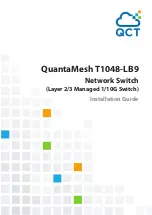
Overview
26
Director 2/64 Installation Guide
Each CTP2 card provides System Services Processor (SSP) and Embedded Port
(EP) subsystems. The SSP subsystem runs director applications, communicates
with director ports, and controls the RS-232 maintenance port and 10/100 Mbps
ethernet port. The EP subsystem provides Class F processing, and manages frame
transmission to and from the Serial Crossbar Assembly (SBAR). In addition,
CTP2 cards provide non-volatile memory for storing firmware director
configuration information, persistent operating parameters, and memory dump
files. Director firmware is upgraded concurrently (without disrupting operation).
Each card faceplate contains a green light emitting diode (LED) that turns O
N
if
the card is operational and active, and an amber LED that turns O
N
if the card
fails. The LEDs are O
FF
on the backup CTP2. The amber LED F
LASHES
if
beaconing is enabled.
Front Bezel
The bezel at the front of the Director includes two indicator LEDs. The green
power LED turns O
N
when the director is powered on and operational. If the LED
turns O
FF
, a facility power source, alternating current (AC) power cord, or director
power distribution failure is indicated.
The amber system error LED turns O
N
when the director detects an event
requiring immediate operator attention, such as an FRU failure. The LED remains
illuminated as long as an event is active. The LED F
LASHES
if unit beaconing is
enabled.
Cable Management Assembly
The cable management assembly positioned at the front of the director provides
routing for Ethernet cables attached to CTP2 cards and fiber-optic cables attached
to director ports. The assembly rotates up to provide front access to the redundant
power supplies.
The cable management assembly is supplied with rack-mount kits for the
HP 9000, HP 10000, and HP 11000 Series racks only
Power Supplies
The Director 2/64 uses redundant, load-sharing power supplies which step down
and rectify facility input power to provide 48-VDC power to Director FRUs. The
power supplies also provide over-voltage and over-current protection. Either
power supply can be replaced while the switch is powered on and operational.
Each power supply has a separate backplane connection to allow for different AC
power sources.
















































